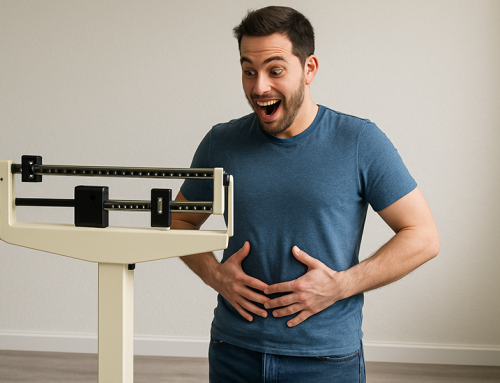Spot reduction of body fat is the theory that you can burn fat preferentially from one area of the body by doing exercises which target that specific spot. The most common example: doing a ton of ab exercises, trying to burn off the belly fat that covers up the abs (hundreds of reps of crunches, sit-ups, leg raises and so on).
 Another example would be doing a lot of thigh or hip exercises, hoping to burn fat off those areas of stubborn lower body fat.
Another example would be doing a lot of thigh or hip exercises, hoping to burn fat off those areas of stubborn lower body fat.
Some people want to burn fat off parts of their upper body as well. I’m often asked how to burn fat off the back of the arms (aka “bingo wings”). What this implies is that someone is asking what tricep exercises they should do to burn fat off their triceps.
Whatever the body part where a person stores the most fat (or most disliked fat), it’s a common, and almost natural question to ask what exercises will burn the fat off of that trouble spot.
It’s not a dumb or silly question. For someone who doesn’t study exercise physiology for a living, it seems intuitive to assume that if you did a lot of exercises for your abs, you might burn more fat from that area. Unfortunately that’s not how fat loss works.
The purpose of resistance training exercises for the abs, thighs, hips, arms and other body parts, is to build strength, muscle, and depending on the number of reps, endurance. Lifting doesn’t burn much fat, and when it does, the fat isn’t burned from one single spot alone.
How fat loss really works
Fat loss starts with a chronic calorie deficit. That means you eat less than you burn. No fat loss from anywhere on your body happens without a deficit, even if you’re doing marathon amounts of exercise – weights, cardio, or both.
When a deficit is achieved, the shortfall is met by pulling energy out of adipose tissue (stored fat). Where does the fat come from? It’s drawn from all over your body, though it may not be drawn equally from everywhere.
Body fat is deposited (in a calorie surplus) and withdrawn (in a calorie deficit) in a pattern based a lot on genetics. It’s also based on gender. Males and females store fat differently.
In men, more fat is stored first in the waistline region. In women, more fat is stored first in the hips and thighs. (That may change during menopause, when more fat may be stored in the belly).
The reason fat is stored or released in specific areas more or less than others may be related to hormones, catecholamines, adrenoreceptors, and blood flow. Understanding this physiological stuff might help some people lose the final deposits of stubborn fat once they’re already lean and want to get the last bits of fat off. But stubborn fat loss is not the same as spot reduction, and that’s a key point to remember.
There’s not much you can do to burn fat from one spot on the body before it’s lost from other areas.
There’s also nothing you can do to change your body’s normal fat storage and fat loss pattern.
To get all the fat off, you simply have to keep dieting (in a deficit) until all the fat – even the last bits of stubborn fat – are gone. You’re not going to change where the fat is pulled from first, at least not significantly.
Fat storage patterns can vary from person to person, but in general, the way fat loss works for everyone is “first on, last off” which is easy to remember with the acronym F.O.L.O.
The first place you store fat when you’re in a calorie surplus is the last place it comes off when you’re in a calorie deficit. Some people consider primary storage sites like the belly or thighs the “stubborn” areas and they wish they could take the fat off those spots first. But wishing doesn’t make it so.
A great way to help you understand it better is to consider the swimming pool analogy. Imagine an in-ground pool with a shallow end and a deep end. There’s no way to drain the deep end of the pool before the shallow end. The shallow end must empty out before the deep end simply because that’s how gravity works and how water flows, right?
Think of those primary fat storage sites like the deep end of the pool. There’s no way to drain the fat from those areas first before the rest of your body. The places you put the fat on first will be the last to come off.
No matter how much extra exercise you do for your abs, or hips, or thighs, or triceps, it won’t burn fat only from those areas. Best case scenario, you might release a tiny bit of additional fat due to the proximity of that fat to the exercised area, where blood flow has been increased, but there is little evidence that it amounts to anything significant.
Some research has also hinted that there’s a possibility certain exercise protocols could encourage the very last of the stubborn fat deposits to be more easily liberated, but the consensus in the exercise science field today is that spot reduction, as most people think of it, is not possible.
60 years of research shows spot reduction from targeted exercise does not occur
Many studies, dating back as far as the 1960s, have been done to test the spot reduction hypothesis and see if it holds any water.
A study was done in 2011 at Southern Illinois University which got a lot of press because it measured the effect of hundreds of reps of weekly abdominal exercises on abdominal fat.
There was a control group and an abdominal exercise group. The ab exercise group did 7 exercises for 2 sets of 10 reps, 5 days a week for 6 weeks. The control group did no ab exercises.
Both groups maintained an isocaloric diet through the entire study. At the end of the month and a half experiment, the researchers took body fat measurements. They used DEXA scans as well as skinfold testing.
Results: After thousands of reps of ab training, there was no effect of the ab exercises on body weight, body fat percentage, belly fat, waist circumference, ab skinfolds, or hip-bone skinfolds.
Some good news: As you might imagine, after exercise testing at the end of the study, the exercise group did improve their ab muscle endurance more than the no exercise group. If they had dieted properly to remove the fat, it’s likely they would have uncovered nice abs as a result of the intensive training. But ab exercise alone is not enough to reveal the muscles when they are still covered with a layer of fat.
A similar study done previously found no change in girth at the waistline after a 27-day sit up program. If studies like these were repeated with a controlled diet (ensuring a calorie deficit), there’s no doubt that abdominal fat would be lost, but fat would be lost all over the whole body. It would also come off in the expected order of the fat storage and removal pattern (F.O.L.O.), leaving the usual stubborn fat locations the last to go.
We have no reason to believe extra ab training would cause fat to come primarily off the abs, and there’s little evidence that a larger percentage of fat would get pulled from the ab region.
One of the reasons the spot reduction myth never seems to die is because of the fitness industry itself. The desire for chiseled abs is so great that ab training programs and machines are often promoted as a way to reduce ab fat and trim down the waistline. As you’ve seen, the evidence doesn’t support this claim – it’s false advertising.
The researchers in the 2011 study explained:
“Some people attempt to reduce their waistline by solely performing ab exercises because of claims made by various ab equipment advertisements. The information obtained from our study can help people understand that abdominal exercise alone is not sufficient to reduce waistline or ab fat. It is likely necessary to include aerobic exercise along with reduding calorie intake to have more favorable changes in body fat percentage.”
Okay, but these studies only looked at the abs. What about the lower body?
Studies on spot reduction in the lower body have been done too.
A group of physiologists from Las Lagos University in Chile did a clever experiment. They put one group on a program of leg presses with light weight and high reps, but only for their non-dominant leg (960 to 1200 reps total per workout). They did this 3 times a week for 12 weeks. A second group did no training.
The training group did lose significant body fat overall, but there was no difference in fat loss between legs, which you’d expect after thousands of reps per week, if spot reduction were possible.
And what about the upper body? How about the arms? Yep, scientists have looked into that as well.
One of the oldest studies on spot reduction examined the body fat level in the arms of tennis players. Again, if spot reduction were possible, it would be logical to expect that the dominant arm (that swung the racquet thousands of times) would have less fat than the other arm. What they actually found was more muscle in the dominant arm, but no difference in the subcutaneous fat layer between arms.
If studies like these have time and time again found no difference in localized fat loss by doing exercise for a specific area, then why does it always seem there’s continued interest in and controversy over this topic? Well, the interest will always be there because again, unscrupulous fitness companies promote it. Plus, it’s a natural idea to think doing lots of ab work will burn fat off your abs. Certainly, a lot of people hope and wish it were true.
The controversy comes in because every so often a study gets published that suggests, “spot reduction is possible after all!” Inevitably then, the news sites, blogs, and podcasts blow up with discussion, and the whole debate is renewed once again. This has been going on for years.
Research shows spot “lipolysis” may occur… but that’s not “spot reduction”
One of the studies that made people think spot reduction of bod fat was really possible was published back in 2007 in the American Journal of Physiology, Endocrinology and Metabolism. Like other studies, it had the subjects do a ton of exercise for a single leg because they wanted to measure what happened in the fat cells that were close to those working leg muscles, then compare that to what was going on in the non-working leg.
In this study, they looked at blood flow and lipolysis. As they hypothesized, both increased in the exercised leg, but not the non-exercised leg. The abstract of the study said, “Specific exercises can induce ‘spot lipolysis’ in adipose tissue.”
Right there, people went bananas and said, “See! Spot reduction is possible! There are two problems with that conclusion.
Number one is that most people don’t distinguish between actual fat burning (oxidation) and fat release from the adipocyte (lipolysis). The only thing the study found for sure was that there was an increase in the amount of fat released from fat cells near the working muscle.
It was assumed this was due to the increased blood flow caused by exercising that area. (It’s been theorized that poor blood flow is one of the reasons why stubborn fat is stubborn).
But what often happens is that fatty acids released into general circulation simply end up getting redeposited if muscles don’t continue to need them for fuel. To know if body fat tissue was actually lost (burned, not just released into circulation), fat would have to be measured over an extended period of time. That wasn’t done in this study.
Here’s problem number two: Suppose the body fat released did get burned. How much fat are we talking about? How much extra fat was released specifically near the exercised area compared to fat that was pulled from all over the body?
The study did measure that, and it was a ridiculously small amount. We are not talking kilograms. Not even grams. We are talking about a fraction of a gram of additional fat released from that local area. It’s such a small amount that assuming the fat was burned, it would amount to virtually no visible impact at all.
What this study really told us is that it’s a waste of time to do hundreds or thousands of reps for thighs, or butt, or abs, or arms, hoping that fat will get burned off those areas. Regular progressive resistance weight training would be more effective for building and strengthening the muscles.
If you ensured you had a calorie deficit from proper diet, and did some moderately intense cardio, you would lose far more body fat, all over your whole body, including in the thighs or abs or whatever the “trouble” spot was deemed to be than making heroic efforts to spot reduce with specific body part exercises.
It’s a bit ironic, but this study which people thought meant spot reduction was possible actually demonstrated the opposite, at least if we’re talking quantitatively.
Nevertheless, 10 years later, just when we thought we’d heard the last of it, the spot reduction controversy emerged all over again.
2017 study puts spot reduction back in the spotlight
The only study that ever found true spot reduction was lead by Scotto DiPalumbo and his team from the University of Rome. It was published in the Journal of Sports Medicine And Physical Fitness in 2017.
These scientists knew what the previous researchers had done and what the results were, so they designed a longer-term trial (12 weeks) that measured changes in body fat mass, not just blood flow or lipolysis.
They also noted that previous research didn’t consider different intensities of training, nor did they look at the effect of different exercise combinations and sequences.
Prior investigations found that higher intensity resistance training created a larger release of catecholamines and lead to greater lipolysis. It was also known that rates of fat oxidation during cardio were higher when done after the high intensity resistance training.
On this basis, they hypothesized that combining intense resistance training with steady state cardio afterward might affect the amount of body fat that would be lost from the trained area.
The subjects (16 women between 25 and 40 years old) were split into two groups. One group did resistance training for the upper body followed by aerobic exercise for the lower body. The other group did resistance training for the lower body, followed by aerobic exercise for the upper body (arm ergometer). They did the training sessions 3 times a week for 12 weeks.
Here’s what happened in the spot reduction study:
Total body weight didn’t change that much, but body fat mass did decrease in both groups. There was no difference between groups in the amount of fat lost. However, the group that did upper body resistance training first, then aerobic training, showed a decrease in upper limb fat mass.
The tricep skin folds decreased slightly more in the upper body resistance group. In the lower body resistance training group, the thigh skinfolds decreased slightly more.
The conclusion was that the body regions that were worked with high intensity resistance training before steady state aerobic exercise showed greater fat reduction in those areas.
If we take the results at face value, it looks like spot reduction did take place with this combination and sequence of exercises (something which had never been tested before). Basically, you release the fat with high intensity exercise for a specific area, then burn the fat with lower intensity steady cardio exercise. Fat release (lipolysis), then fat burning (oxidation).
While some people once again took this as evidence that spot reduction is definitely possible, most experts said to interpret these results with caution.
These results have been questioned because of a small sample size, which increases the odds that the results were due to chance. There were also questions about the body fat measurement tools (there were some discrepancies between results from DEXA and skin folds).
Also, like the previous research, they warned that the amount of fat lost might not be anything worth writing home about.
As a result, most folks in the scientific community are still not convinced that spot reduction can be achieved in significant amounts, and insist that more research is needed. Basically, a single study doesn’t overturn the whole body of research that’s accumulated for decades.
Is there a final verdict?
Some people are keeping an open mind that a minor spot reduction effect is plausible when this particular sequence of exercises is utilized. If we believe the results from this one most recent study, we might hold off before saying spot reduction is impossible or is definitely a myth. Some people might take this as encouragement to keep doing their steady state cardio right after lifting.
But if the effect is true and confirmed in future research, it’s most likely that any additional fat loss in the area exercised is very small compared to overall fat loss, and the usual major fat deposits will still be the last to come off.
If we are talking about practical significance, it’s still safe to say that attempting spot reduction by doing a ton of exercise for one specific body part that’s covered with fat is not a productive use of time. The idea that hundreds or even thousands of reps of ab exercises alone will reveal your six pack, for example, can be permanently laid to rest.
On the other hand, some of these findings about blood flow, lipolysis, and high intensity exercise may have implications for losing the last bits of stubborn body fat once you’re already lean. This should not be confused with spot reduction, because it is not the same thing (it makes zero sense to even discuss “stubborn fat” when your body fat level is still high – that’s a contradiction in terms).
But for people like physique athletes, finding techniques to burn stubborn fat so the whole body is “stage ready” is another big area of interest, and will make a good topic for a separate discussion in a future article. In the meantime, if there are any new findings in the spot reduction realm, you can be assured, we will return to this page with all the updates.
Train hard and expect success,
Tom Venuto,
Founder, Burn the Fat Inner Circle
Author, Burn the Fat, Feed the Muscle
Author, Burn the Fat, Feed the Muscle Guide to Building Muscle With Progressive Overload Training
Related:
Can You Tighten Loose, Sagging Skin After Weight Loss?
How Often Should You Train Your Abs?
Scientific References:
DiPalumbo S et al, Effect of combined resistance and endurance exercise training on regional fat loss, The Journal of Sports Medicine and Physical Fitness: 794-801, 2017.
Gwinup G et al, Thickness of subcutaneous fat and activity of underlying muscle. Annals of Internal Medicine, 74:3, 408-411. 1971.
Katch F, Effects of sit up exercise training on adipose cell size and adiposity, Research Quarterly for Exercise and Sport, 55:3, 1177-1185, 2007.
Kostek, M et al. subcutaneous fat alterations resulting from an upper-body resistance training program. Medicine and science in sports and exercise 39:9, 1177. 2007.
Ramirez-Campillo R et al, Regional fat changes induced by localized muscle endurance resistance training, Journal of strength and conditioning research, 27:8, 2219-2224, 2013.
Schade M et al, Spot reducing in overweight college women: its influence on fat distribution as determined by photography, Research Quarterly, 33, 461-471, 1962.
Stallknecht B et al, are blood flow and lipolysis in subcutaneous adipose tissue influenced by contractions in adjacent muscles in humans, American Journal of Physiology Endocrinology and Metabolism, 292, 394-399, 2007.
Vispute S et al, The effect of abdominal exercise on abdominal fat. Journal of strength and conditioning research. 25:9, 2559-2564. 2011.






Lovely intro to your newsletter. Beautifully said. Thank you for saying what many are also feeling.